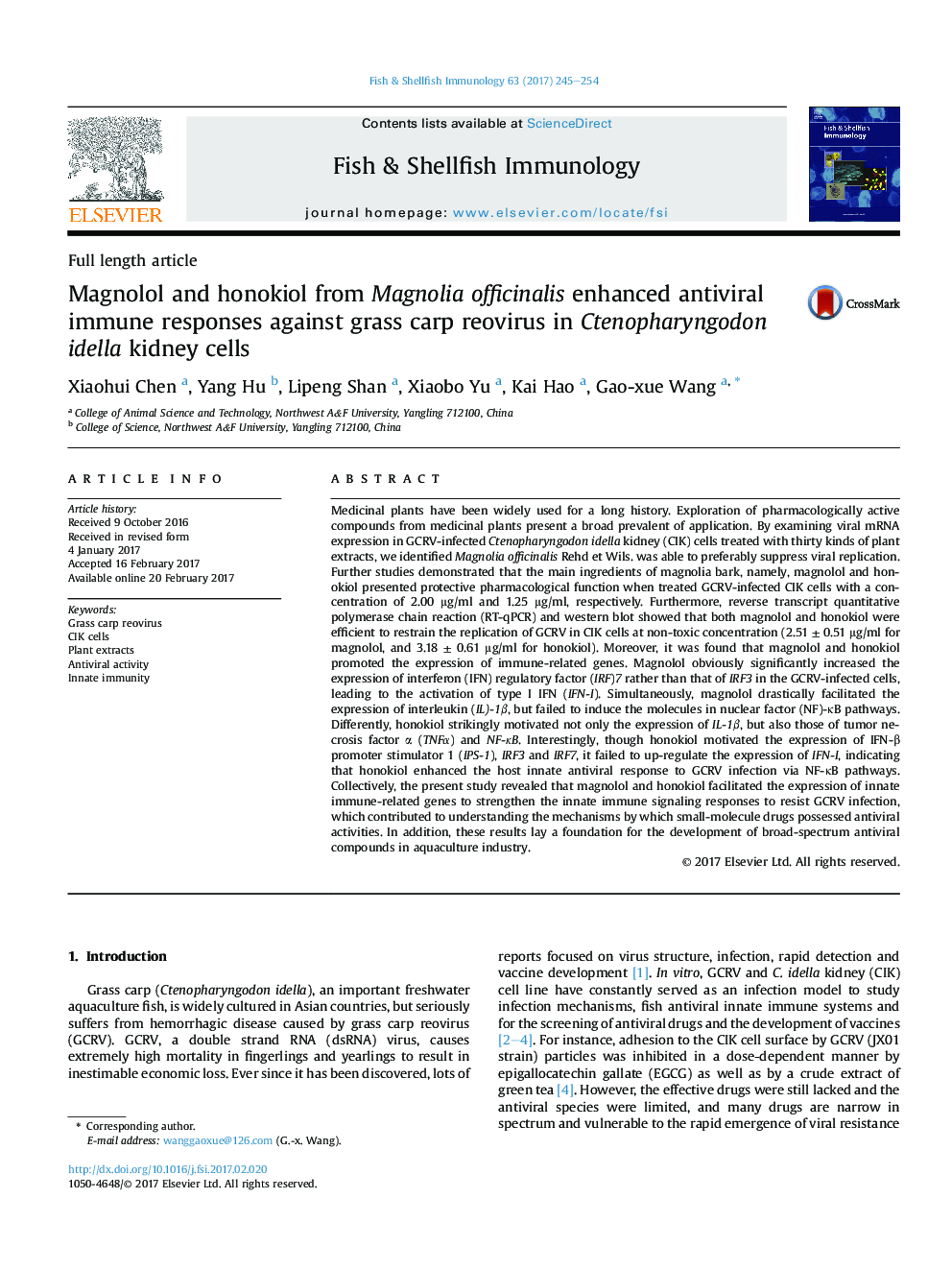| کد مقاله | کد نشریه | سال انتشار | مقاله انگلیسی | نسخه تمام متن |
|---|---|---|---|---|
| 5540924 | 1553611 | 2017 | 10 صفحه PDF | دانلود رایگان |
عنوان انگلیسی مقاله ISI
Magnolol and honokiol from Magnolia officinalis enhanced antiviral immune responses against grass carp reovirus in Ctenopharyngodon idella kidney cells
دانلود مقاله + سفارش ترجمه
دانلود مقاله ISI انگلیسی
رایگان برای ایرانیان
کلمات کلیدی
موضوعات مرتبط
علوم زیستی و بیوفناوری
علوم کشاورزی و بیولوژیک
علوم آبزیان
پیش نمایش صفحه اول مقاله

چکیده انگلیسی
Medicinal plants have been widely used for a long history. Exploration of pharmacologically active compounds from medicinal plants present a broad prevalent of application. By examining viral mRNA expression in GCRV-infected Ctenopharyngodon idella kidney (CIK) cells treated with thirty kinds of plant extracts, we identified Magnolia officinalis Rehd et Wils. was able to preferably suppress viral replication. Further studies demonstrated that the main ingredients of magnolia bark, namely, magnolol and honokiol presented protective pharmacological function when treated GCRV-infected CIK cells with a concentration of 2.00 μg/ml and 1.25 μg/ml, respectively. Furthermore, reverse transcript quantitative polymerase chain reaction (RT-qPCR) and western blot showed that both magnolol and honokiol were efficient to restrain the replication of GCRV in CIK cells at non-toxic concentration (2.51 ± 0.51 μg/ml for magnolol, and 3.18 ± 0.61 μg/ml for honokiol). Moreover, it was found that magnolol and honokiol promoted the expression of immune-related genes. Magnolol obviously significantly increased the expression of interferon (IFN) regulatory factor (IRF)7 rather than that of IRF3 in the GCRV-infected cells, leading to the activation of type I IFN (IFN-I). Simultaneously, magnolol drastically facilitated the expression of interleukin (IL)-1β, but failed to induce the molecules in nuclear factor (NF)-κB pathways. Differently, honokiol strikingly motivated not only the expression of IL-1β, but also those of tumor necrosis factor α (TNFα) and NF-κB. Interestingly, though honokiol motivated the expression of IFN-β promoter stimulator 1 (IPS-1), IRF3 and IRF7, it failed to up-regulate the expression of IFN-I, indicating that honokiol enhanced the host innate antiviral response to GCRV infection via NF-κB pathways. Collectively, the present study revealed that magnolol and honokiol facilitated the expression of innate immune-related genes to strengthen the innate immune signaling responses to resist GCRV infection, which contributed to understanding the mechanisms by which small-molecule drugs possessed antiviral activities. In addition, these results lay a foundation for the development of broad-spectrum antiviral compounds in aquaculture industry.
ناشر
Database: Elsevier - ScienceDirect (ساینس دایرکت)
Journal: Fish & Shellfish Immunology - Volume 63, April 2017, Pages 245-254
Journal: Fish & Shellfish Immunology - Volume 63, April 2017, Pages 245-254
نویسندگان
Xiaohui Chen, Yang Hu, Lipeng Shan, Xiaobo Yu, Kai Hao, Gao-xue Wang,